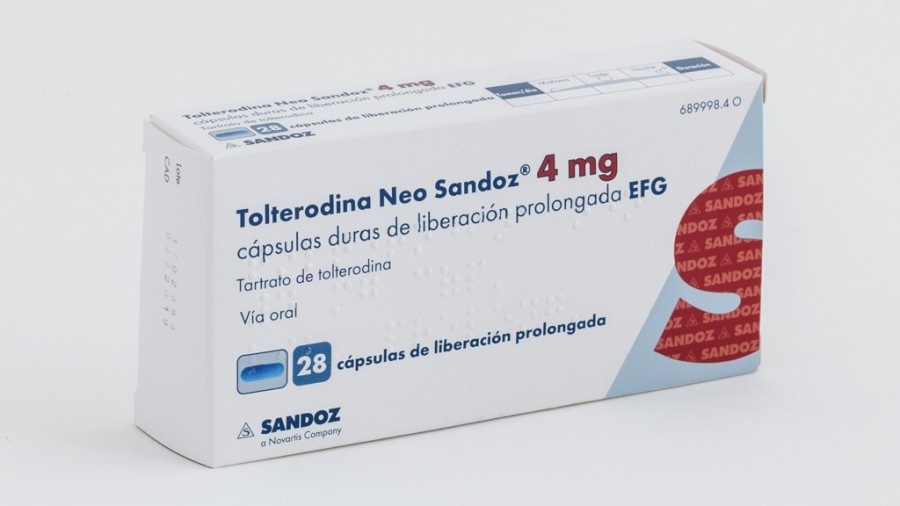

ТОЛТЕРОДИН НЕО РАТИОФАРМ 4 мг КАПСУЛЫ ПРОЛОНГИРОВАННОГО ДЕЙСТВИЯ ТВЕРДЫЕ

Спросите врача о рецепте на ТОЛТЕРОДИН НЕО РАТИОФАРМ 4 мг КАПСУЛЫ ПРОЛОНГИРОВАННОГО ДЕЙСТВИЯ ТВЕРДЫЕ

Инструкция по применению ТОЛТЕРОДИН НЕО РАТИОФАРМ 4 мг КАПСУЛЫ ПРОЛОНГИРОВАННОГО ДЕЙСТВИЯ ТВЕРДЫЕ
Введение
Инструкция: информация для пациента
Толтеродина Нео ратиофарм 4 мг твердые капсулы с продленным высвобождением ЕФГ
толтеродина, тартрат
Прочитайте внимательно всю инструкцию перед началом приема этого лекарства, поскольку она содержит важную информацию для вас.
- Сохраните эту инструкцию, поскольку вам может потребоваться прочитать ее снова.
- Если у вас есть какие-либо вопросы, проконсультируйтесь с вашим врачом или фармацевтом.
- Это лекарство было назначено только вам и не должно быть передано другим людям, даже если у них такие же симптомы, как у вас, поскольку оно может нанести им вред.
- Если вы испытываете побочные эффекты, проконсультируйтесь с вашим врачом или фармацевтом, даже если это побочные эффекты, которые не указаны в этой инструкции. См. раздел 4.
Содержание инструкции
- Что такое Толтеродина Нео ратиофарм и для чего оно используется
- Что вам нужно знать перед началом приема Толтеродины Нео ратиофарм
- Как принимать Толтеродину Нео ратиофарм
- Возможные побочные эффекты
- Хранение Толтеродины Нео ратиофарм
- Содержание упаковки и дополнительная информация
1. Что такое Толтеродина Нео ратиофарм и для чего оно используется
Активным веществом в Толтеродине Нео ратиофарм является толтеродина. Толтеродина относится к группе лекарств, называемых антихолинергическими.
Толтеродина Нео ратиофарм используется для лечения симптомов синдрома гиперактивного мочевого пузыря. Если у вас есть синдром гиперактивного мочевого пузыря, вы можете заметить, что:
- вы не можете контролировать мочеиспускание добровольно
- вы испытываете внезапную и сильную потребность в мочеиспускании без предварительного предупреждения и/или что увеличивается количество раз, когда вы мочитесь днем.
2. Что вам нужно знать перед началом приема Толтеродины Нео ратиофарм
Не принимайте Толтеродину Нео ратиофарм
- если вы аллергичны к толтеродине или к любому другому компоненту этого лекарства (перечисленному в разделе 6).
- если вы не можете вывести мочу из мочевого пузыря (задержка мочи).
- если у вас есть не контролируемый глаукома с узким углом (высокое внутриглазное давление с потерей поля зрения, которое не лечится должным образом).
- если у вас есть миастения гравис (чрезмерная слабость мышц).
- если у вас есть тяжелый язвенный колит (язвы и воспаление в толстой кишке).
- если у вас есть токсический мегаколон (острая расширение толстой кишки).
Предостережения и меры предосторожности
Проконсультируйтесь с вашим врачом или фармацевтом перед началом приема Толтеродины Нео ратиофарм:
- если вы испытываете трудности с мочеиспусканием и/или мочитесь с слабым или медленным потоком.
- если у вас есть желудочно-кишечное расстройство, которое влияет на прохождение и/или переваривание пищи.
- если у вас есть проблемы с почками (почечная недостаточность).
- если у вас есть болезнь печени.
- если у вас есть неврологические расстройства, которые влияют на ваше кровяное давление, функцию кишечника или сексуальную функцию (любые аутоиммунные невропатии).
- если у вас есть грыжа пищеводного отверстия диафрагмы (грыжа в брюшной полости).
- если вы когда-либо испытывали уменьшение движений кишечника или страдаете тяжелым запором (уменьшение кишечной мотильности).
- если у вас есть сердечное заболевание, такое как:
- нарушение сердечного ритма (ЭКГ)
- замедление сердечного ритма (брадикардия),
- предшествующие сердечные заболевания, такие как: кардиомиопатия (слабость сердечной мышцы), ишемия миокарда (уменьшение кровотока к сердцу), аритмия (нарушение сердечного ритма), сердечная недостаточность
- если у вас есть аномально низкие уровни калия (гипокалиемия), кальция (гипокальциемия) или магния (гипомагниемия) в крови.
Прием Толтеродины Нео ратиофарм с другими лекарствами
Сообщите вашему врачу или фармацевту, если вы принимаете, недавно принимали или можете принимать другие лекарства.
Толтеродина, активное вещество Толтеродины Нео ратиофарм, может взаимодействовать с другими лекарствами.
Не рекомендуется принимать толтеродину в сочетании с:
- некоторыми антибиотиками (содержащими, например, эритромицин и кларитромицин).
- лекарствами, используемыми для лечения грибковых инфекций (содержащими, например, кетоконазол и итраконазол).
- лекарствами, используемыми для лечения ВИЧ.
Толтеродина Нео ратиофарм должно использоваться с осторожностью при совместном применении с:
- некоторыми лекарствами, которые влияют на прохождение пищи (содержащими, например, метоклопрамид и цисаприд).
- лекарствами для лечения нерегулярного сердечного ритма (содержащими, например, амиодарон, соталол, хинидин и прокаинамид.
- другими лекарствами, которые имеют подобный механизм действия, как толтеродина (антихолинергические свойства), или лекарствами, которые имеют противоположный механизм действия Толтеродине Нео ратиофарм (холинергические свойства). Уменьшение желудочной мотильности, вызванное антихолинергическими лекарствами, может повлиять на абсорбцию других лекарств.
Прием Толтеродины Нео ратиофарм с пищей
Толтеродина Нео ратиофарм можно принимать до, во время или после еды.
Беременность и лактация
Если вы беременны или кормите грудью, думаете, что можете быть беременной или планируете стать беременной, проконсультируйтесь с вашим врачом или фармацевтом перед использованием этого лекарства.
Беременность
Не принимайте Толтеродину Нео ратиофарм, если вы беременны.
Лактация
Неизвестно, выделяется ли толтеродина в грудное молоко. Не рекомендуется использовать Толтеродину Нео ратиофарм во время грудного вскармливания.
Вождение и использование машин
Толтеродина Нео ратиофарм может вызывать головокружение, сонливость или影响ать ваше зрение. Если вы испытываете любой из этих симптомов, не驾驶уйте и не используйте тяжелую технику.
Толтеродина Нео ратиофарм содержит лактозу и натрий
Если ваш врач сказал вам, что у вас есть непереносимость некоторых сахаров, проконсультируйтесь с ним перед приемом этого лекарства.
Это лекарство содержит менее 23 мг натрия (1 ммоль) на капсулу; это означает, что оно практически не содержит натрия.
3. Как принимать Толтеродину Нео ратиофарм
Следуйте точно инструкциям по приему этого лекарства, указанным вашим врачом. Проконсультируйтесь с вашим врачом или фармацевтом, если у вас есть какие-либо вопросы.
Взрослые
Рекомендуемая доза составляет 1 капсулу 4 мг в день.
Пациенты с проблемами печени или почек
У пациентов с проблемами печени или почек врач может снизить дозу до 2 мг толтеродины в день.
Использование у детей
Не рекомендуется использовать Толтеродину Нео ратиофарм у детей.
Форма приема
Твердые капсулы с продленным высвобождением принимаются перорально и должны проглатываться целиком.
Не жуйте капсулы.
Продолжительность лечения
Ваш врач укажет продолжительность лечения Толтеродиной Нео ратиофарм. Не прерывайте лечение раньше, чем вы не увидите немедленного эффекта. Вашему мочевому пузырю нужно время, чтобы адаптироваться к этому. Завершите лечение капсулами с продленным высвобождением, назначенными вашим врачом. Если вы не заметите никакого эффекта, проконсультируйтесь с вашим врачом. Эффективность лечения должно быть переоценена через 2-3 месяца после начала приема.
Если вы приняли слишком много Толтеродины Нео ратиофарм
В случае передозировки или случайного приема проконсультируйтесь немедленно с вашим врачом или фармацевтом или позвоните в Центр токсикологической информации, телефон 91 562 04 20, указав лекарство и количество, принятое. Рекомендуется взять с собой упаковку и инструкцию к лекарству, чтобы показать их медицинскому специалисту.
Симптомы передозировки включают галлюцинации, возбуждение, ускорение сердечного ритма, расширение зрачков и невозможность мочиться или дышать нормально.
Если вы пропустили прием Толтеродины Нео ратиофарм
Если вы пропустили дозу в назначенное время, примите ее как можно скорее, если только это не время следующей дозы. В этом случае пропустите пропущенную дозу и продолжайте принимать лекарство по назначенному графику.
Не принимайте двойную дозу, чтобы компенсировать пропущенную.
Если вы прекратите лечение Толтеродиной Нео ратиофарм
Всегда проконсультируйтесь с вашим врачом, если вы думаете прекратить лечение.
Если у вас есть какие-либо другие вопросы о использовании этого лекарства, проконсультируйтесь с вашим врачом или фармацевтом.
4. Возможные побочные эффекты
Как и все лекарства, это лекарство может вызывать побочные эффекты, хотя не все люди испытывают их.
Проконсультируйтесь с вашим врачом немедленно или обратитесь за помощью в больницу, если вы испытываете симптомы ангioneуротического отека, такие как:
- отек лица, языка или горла.
- затруднение глотания.
- крапивница и затруднение дыхания.
Кроме того, обратитесь за медицинской помощью, если вы испытываете аллергическую реакцию (например, зуд, сыпь, крапивница и затруднение дыхания). Это происходит редко (может затронуть до 1 из 100 человек).
Сообщите вашему врачу немедленно или обратитесь за помощью в больницу, если вы испытываете:
- боль в груди, затруднение дыхания или усталость (даже в покое), затруднение дыхания ночью, отек ног.
Это могут быть симптомы сердечной недостаточности. Это происходит редко (может затронуть до 1 из 100 человек).
Следующие побочные эффекты были обнаружены во время лечения толтеродиной, с следующими частотами:
Очень частые побочные эффекты(могут затронуть более 1 из 10 человек):
- сухость во рту
Частые побочные эффекты(могут затронуть до 1 из 10 человек):
- синусит
- головокружение, сонливость, головная боль
- сухость глаз, размытое зрение
- затруднение пищеварения (диспепсия), запор, боль в животе, избыточное газообразование в желудке или кишечнике
- боль или затруднение при мочеиспускании
- диарея
- отек, вызванный накоплением жидкости (например, на ногах)
- усталость
Редкие побочные эффекты(могут затронуть до 1 из 100 человек):
- аллергические реакции
- сердечная недостаточность
- нервозность
- нарушение сердечного ритма, сердцебиение
- боль в груди
- невозможность опорожнить мочевой пузырь
- чувство онемения в пальцах рук и ног
- вертиго
- нарушение памяти
Дополнительные реакции, сообщенные включают тяжелые аллергические реакции, конфузию, галлюцинации, увеличение частоты сердечных сокращений, покраснение кожи, изжогу, рвоту, ангioneуротический отек и сухость кожи, а также дезориентацию. Были сообщены случаи ухудшения симптомов деменции у пациентов, проходящих лечение для деменции.
Сообщение о побочных эффектах:
Если вы испытываете любой побочный эффект, проконсультируйтесь с вашим врачом или фармацевтом, даже если это возможные побочные эффекты, которые не указаны в этой инструкции. Вы также можете сообщить о них напрямую через систему фармаковигиланса для лекарств для человека: https://www.notificaram.es. Сообщая о побочных эффектах, вы можете внести свой вклад в предоставление более полной информации о безопасности этого лекарства.
5. Хранение Толтеродины Нео ратиофарм
Храните это лекарство в недоступном для детей месте.
Не используйте это лекарство после истечения срока годности, указанного на упаковке и блистере. Срок годности - последний день месяца, указанного.
Не храните при температуре выше 25°C.
Бутылка из ПНД: срок годности после первого открытия - 200 дней.
Лекарства не должны выбрасываться в канализацию или мусор. Сдавайте упаковку и лекарства, которые вам больше не нужны, в аптеку. Спросите вашего фармацевта, как правильно утилизировать упаковку и лекарства, которые вам больше не нужны. Таким образом, вы поможете защитить окружающую среду.
6. Содержание упаковки и дополнительная информация
Состав Толтеродины Нео ратиофарм
- Активным веществом является тартрат толтеродины.
Каждая твердая капсула с продленным высвобождением содержит 4 мг тартрата толтеродины, что эквивалентно 2,74 мг толтеродины.
- Другими компонентами являются: лактоза моногидрат, микрокристаллическая целлюлоза, поливиниловый ацетат, повидон, диоксид кремния, лаурилсульфат натрия, докузат натрия, стеарат магния, гидроксипропилметилцеллюлоза.
Состав капсулы: кармин индиго (Е132), диоксид титана (Е171) и желатина.
Состав покрытия таблетки: этилцеллюлоза, триэтилцитрат, метакриловая кислота - сополимер этилакрилата, 1,2-пропиленгликоль.
Внешний вид продукта и содержание упаковки
Толтеродина Нео ратиофарм - это твердые капсулы с продленным высвобождением, предназначенные для приема одной капсулы в день.
Твердые капсулы с продленным высвобождением Толтеродины Нео ратиофарм 4 мг имеют светло-синий цвет и являются непрозрачными.
Толтеродина Нео ратиофарм 4 мг твердые капсулы с продленным высвобождением доступны в следующих размерах упаковок:
Блистеры по 7, 14, 28, 30, 49, 50, 80, 84, 90, 98, 100, 160, 200 и 280 твердых капсул с продленным высвобождением.
Бутылки из ПНД с 30, 60, 100 и 200 капсулами.
Возможно, не все размеры упаковок доступны.
Владелец разрешения на маркетинг и производитель
Владелец разрешения на маркетинг
Teva Pharma, S.L.U.
улица Анабель Сегура, 11, здание Альбатрос Б, 1-й этаж
28108 Алькобендас, Мадрид
Производитель
Pharmathen S.A
6, Дервенакион стр.,
153 51 Паллини Аттики
Греция
Или
Pharmathen International S.A
Промышленная зона Сапес
Блок 5, 69300 Родопи
Греция
Или
МERCKLE GMBH
улица Людвиг-Мерckle-Штрассе, 3
Д-89143 Блаубойрен, Германия
Это лекарство разрешено к маркетингу в государствах-членах Европейского экономического пространства под следующими названиями:
Великобритания: Dengaff XL 4 мг пролонгированные капсулы
Германия: Tolterodin-CT 4 мг пролонгированные капсулы
Испания: Толтеродина Нео ратиофарм 4 мг твердые капсулы с продленным высвобождением ЕФГ
Финляндия: Tolterodine Teva 4mg депо-капсула, твердая
Дата последнего пересмотра этой инструкции: сентябрь 2020 г.
Подробная и актуальная информация о этом лекарстве доступна на сайте Агентства по лекарствам и медицинским изделиям Испании (AEMPS) (http://www.aemps.gob.es/)

Сколько стоит ТОЛТЕРОДИН НЕО РАТИОФАРМ 4 мг КАПСУЛЫ ПРОЛОНГИРОВАННОГО ДЕЙСТВИЯ ТВЕРДЫЕ в Испании в 2025 году?
Средняя цена на ТОЛТЕРОДИН НЕО РАТИОФАРМ 4 мг КАПСУЛЫ ПРОЛОНГИРОВАННОГО ДЕЙСТВИЯ ТВЕРДЫЕ в декабрь, 2025 года составляет около 28.58 евро. Финальная стоимость может зависеть от региона, конкретной аптеки и рецептурного статуса. Для точной информации лучше проверить онлайн или в ближайшей аптеке.
- Страна регистрации
- Средняя цена в аптеках28.58 EUR
- Активное вещество
- Требуется рецептДа
- Производитель
- Информация носит справочный характер и не является медицинской рекомендацией. Перед приемом любых препаратов проконсультируйтесь с врачом. Oladoctor не несет ответственности за медицинские решения, принятые на основе этого контента.
- Аналоги ТОЛТЕРОДИН НЕО РАТИОФАРМ 4 мг КАПСУЛЫ ПРОЛОНГИРОВАННОГО ДЕЙСТВИЯ ТВЕРДЫЕФорма выпуска: ТАБЛЕТКА, 2 мгАктивное вещество: tolterodineПроизводитель: Farmasierra Laboratorios S.L.Требуется рецептФорма выпуска: КАПСУЛА С МОДИФИЦИРОВАННЫМ ВЫСВОБОЖДЕНИЕМ, 4 мгАктивное вещество: tolterodineПроизводитель: Farmasierra Laboratorios S.L.Требуется рецептФорма выпуска: КАПСУЛА С МОДИФИЦИРОВАННЫМ ВЫСВОБОЖДЕНИЕМ, 4 мгАктивное вещество: tolterodineПроизводитель: Aurovitas Spain, S.A.U.Требуется рецепт
Аналоги ТОЛТЕРОДИН НЕО РАТИОФАРМ 4 мг КАПСУЛЫ ПРОЛОНГИРОВАННОГО ДЕЙСТВИЯ ТВЕРДЫЕ в других странах
Лучшие аналоги с тем же действующим веществом и терапевтическим эффектом.
Аналог ТОЛТЕРОДИН НЕО РАТИОФАРМ 4 мг КАПСУЛЫ ПРОЛОНГИРОВАННОГО ДЕЙСТВИЯ ТВЕРДЫЕ в Польша
Врачи онлайн по ТОЛТЕРОДИН НЕО РАТИОФАРМ 4 мг КАПСУЛЫ ПРОЛОНГИРОВАННОГО ДЕЙСТВИЯ ТВЕРДЫЕ
Консультация по дозировке, побочным эффектам, взаимодействиям, противопоказаниям и продлению рецепта на ТОЛТЕРОДИН НЕО РАТИОФАРМ 4 мг КАПСУЛЫ ПРОЛОНГИРОВАННОГО ДЕЙСТВИЯ ТВЕРДЫЕ – по решению врача и с учетом местных правил.







